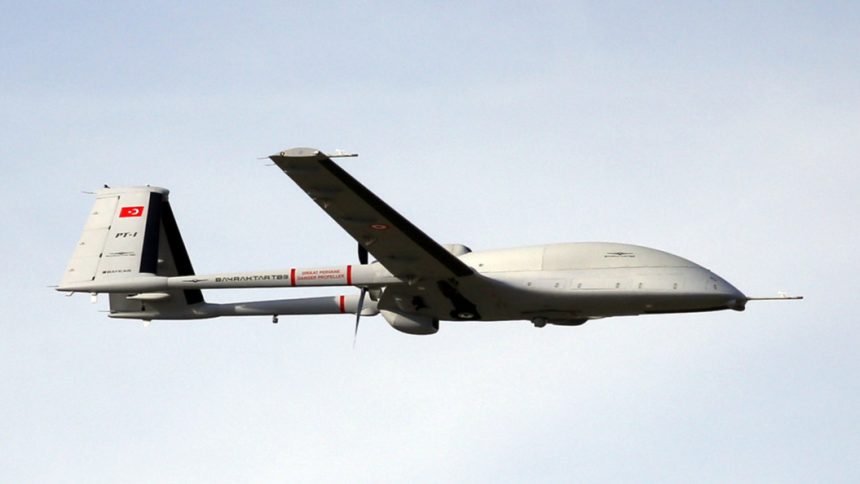The TB3 has so far logged 445 hours and 3 minutes of flight time during testing, with this being its 55th test flight.
Turkey’s Bayraktar TB3 UCAV (Unmanned Combat Aerial Vehicle), developed to operate from the country’s first aircraft carrier, the TCG Anadolu, clocked its highest altitude at 36,310 feet on Jun. 26, 2024, its developer Baykar announced.
Reports credit the achievement to the drone’s domestically built TEI (Tusas Engine Industries) PD-170 engine. Baykar mentioned the test was flown to validate the drone’s performance and control features at high-altitudes.
The drone’s performance also brings it closer to the national record set by the Akinci B UCAV, which had touched a height of 45,118 feet on Jun. 21, 2022. With the possibility of being fitted with folding wings, the TB3 has often been described as a naval variant of the Bayraktar TB2, compatible with the TCG Anadolu which is being envisioned as a drone carrier and an amphibious assault ship.
The Aviationist reported on May 28 that the TB3 was slated to operate from off a land-based runway with a 12 degree-inclined ski-jump, before the beginning of the actual trials off the Anadolu. The test flight was finally conducted on Jun. 1. Baykar plans to begin testing the TB3 on the TCG Anadolu in 2024, Baykar Chairperson Selçuk Bayraktar previously announced.
#BayraktarTB3 | Yerli Motor ile Çıkılan En Yüksek İrtifa ✈️⚓️🚀
✈️ 36.310 Feet Yükseklik
✅ 55. Uçuş | Yüksek İrtifa Sistem Tanımlama ve Performans Testi
#BayraktarTB3 | Altitude Record with Indigenous Engine ✈️⚓️🚀
✈️ Altitude: 36,310 Feet
✅ 55th Flight | High-Altitude… pic.twitter.com/O3Dp08LfJa
— BAYKAR (@BaykarTech) June 25, 2024
According to Turkish defense commentator Turan Oguz, the drone’s previous milestone was on Mar. 26, 2023 when it flew with the ASELFIR-500 Electro-Optical Reconnaissance, Surveillance and Targeting System developed by Aselsan.
Drone touches new heights
According to Daily Sabah, the TB3 has logged 445 hours and 3 minutes of flight time so far during the tests, and the latest test was its 55th flight, as confirmed by Baykar. On Dec. 20, 2023, the TB3 completed a 32-hour flight covering 5,700 kilometers. The kinematic features puts the aircraft firmly in the MALE (Medium-Altitude Long-Endurance) class of drones.
The company also released a video of the 55th flight at its Flight Training and Test Center in Edirne’s Keşan district. The TB3 is seen rolling down the runway and taking off, with a camera, seemingly installed on the top of its inverted-v tail, showing a flight control display of the UCAV touching 36,310 feet.
The drone is then shown landing back at the base and returning to the hangar. This is also the same airfield used to test the take-off from the ski-jump, which can be seen towards the end of the runway as the TB3 rolls back to the apron.
Screengrab of the video from the flight control display showing the new max altitude.Steps towards carrier operations
Baykar is gradually validating the drone’s major systems and subsystems before beginning to test it from the Anadolu. The TB3 has already been placed on the drone carrier along with the jet-powered UCAV Kizilelma, as shown in several photos. “Bayraktar TB3, whose test campaign is progressing successfully, is getting closer to embarkation with the successful ramp tests,” said SavunmaSanayi.
The description of its features and capabilities in the Turkish media are fitting for the TB3 being a primarily reconnaissance-strike platform, with BLOS (Beyond-Line-Of-Sight) communications for long-endurance surveillance “intelligence and attack missions” to “significantly” enhance Turkey’s “deterrent capabilities.”
This might also be followed by weapons carriage and release trials, which could include the MAM-L, MAM-C and MAM-T smart guided munitions and a series of other air-launched weapons that Turkey’s rapidly advancing defense industry has developed. Possibly, like the TB2 and the Akinci, TB3 would also be pitched for exports, which have already garnered a significant market.
TCG Anadolu’yu ziyaret ettim. Heybeti insanı büyülüyor ancak Kızılelma ve Bayraktar TB3’ü görmek ayrı bir hissiyat.
İzmir’de olan herkese şiddetle tavsiye ederim. pic.twitter.com/Hb13hamoIC
— Avionot (@avionot) May 4, 2023
Turkey would acquire significant deterrent offensive and defensive capabilities in the Mediterranean with the drone carrying Anadolu, once the UCAVs enter serial production and are inducted in service in large numbers. Turkey has recurring tensions with Greece over contesting maritime boundaries in the eastern Mediterranean.
The TB2 and Akinci meanwhile are being used by major Arab, European, African and central Asian States, including Qatar, UAE, Kuwait, Ukraine, Poland, Romania, Albania, Libya, Azerbaijan, Kyrgyzstan, Turkmenistan, Tajikistan, Pakistan, Morocco, Burkina Faso, Nigeria, Rwanda, Togo, Djibouti, Niger, Mali and Ethiopia. Their affordable price compared to the costlier Western systems made them attractive for developing countries.









